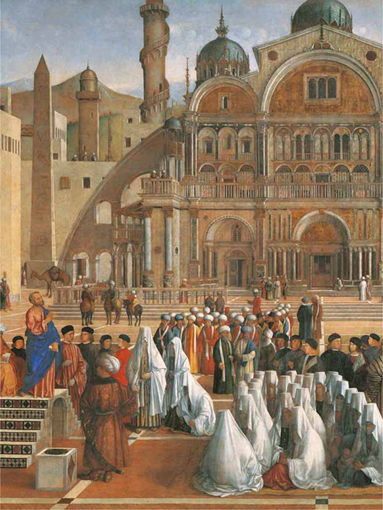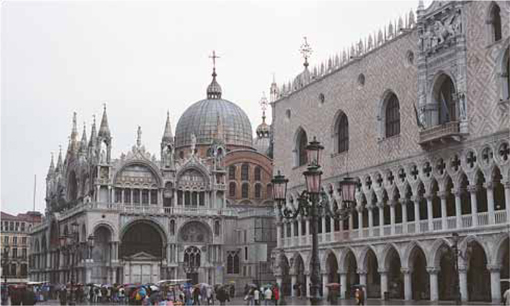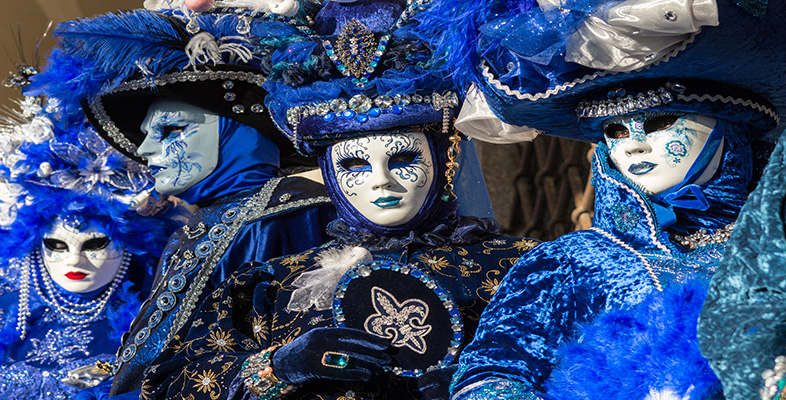1 Art in fifteenth-century Venice: ‘an aesthetic of diversity’
A distinctive place
The Venice Biennale is the longest-running of the major international exhibitions that have come to play such an important part in the contemporary practice of art. Inaugurated as long ago as 1895, the Biennale is organised on national lines. For the fiftieth exhibition in 2003, under the overall rubric of ‘Dreams and conflicts’, the United States pavilion showed work by the African-American artist Fred Wilson. Wilson’s display consisted of a collection of objects and installations addressing the multicultural, multiethnic makeup of Venice itself, from the Renaissance to the twentieth century. The installations included an opulent Murano glass chandelier, in black glass, numerous figures of the ‘blackamoor’ types used to advertise Venetian consumer products from the seventeenth century to the present day and images of Renaissance paintings depicting non-European figures. In the Biennale catalogue the point is made clear: ‘As the world of today struggles again with issues of immigration, ethnicity and race, the topic of diversity in historical Venice is particularly resonant.’ 1
Much of the interest in looking at the Renaissance at the beginning of the twenty-first century lies in this sense of ‘looking again’. At a point when the boundaries of the western canon are coming under greater scrutiny than at any time in its history, it follows that the vaunted ‘rebirth’ of that tradition is itself going to be a suggestive site of encounter for received meanings and interpretations. In historical representation, consciously or otherwise, the horizon of the present is always drawn around the continent of the past. Arguably, a period gets the Renaissance it deserves – or needs. For its early historian Jacob Burckhardt, writing in 1860, the impetus to research the Renaissance was a conviction of its status as ‘a civilisation which is the mother of our own’. 2 Contemporary historians, by contrast, are inclined to explore differences between the fifteenth and sixteenth centuries and our own times. 3 Not only is the map of the societies and cultures that produced Renaissance art substantially redrawn, but our sense of what counts as ‘art’ itself is subject to redescription. In a way that echoes the decentring of painting and sculpture from the contemporary practice of the arts (exemplified by, among others, Wilson’s Venice installation), our sense of Renaissance cultural practice is now moving to re-embed painting and sculpture in a matrix of ritual and building, mechanical reproduction, design and consumption, from which the modern system of the arts detached it. 4 The hierarchical distinctions of the canon have come to seem out of tune with our own cultural hybridity in an epoch of globalisation. That said, no one could sensibly argue with claims for the relevance of an understanding of Renaissance art to the subsequent western tradition. 5 What stands at issue are the terms of that understanding. As new historical enquiry begins to shed light on the diversity of Renaissance experience, the consequences for a sense of western individual identity, as historically grounded in the Renaissance, are considerable. 6

Recurring figures in recent studies of Venetian culture are the collage, the montage or, in another variant, the palimpsest. In all these cases, however, the intention is clear: the figure is meant to bring out the layering of Venetian culture, of Venice as a place of marked juxtapositions. 7 Neither is this a wholly retrospective construct. At the end of the fifteenth century, the French ambassador Philippe de Commynes remarked that ‘most of the people are foreigners’. And this perception of a society in which northerners (Flemish and Germans), Dalmatians, Greeks, Muslims, Jews and mainland Italians mingled with indigenous Venetians was sharpened in the sixteenth century by the Venetian writer Francesco Sansovino: ‘Peoples from the most distant parts of the world gather here to trade and conduct business’, people who ‘differ among themselves in appearance, in customs and in languages’. 8 This characteristic is frequently attributed to Venice’s particular geographical and historical situation: a series of offshore islands in the far north-east of Italy, at the head of the Adriatic, which conferred on Venice a distinctive relation to some of the core values associated with the Renaissance. When one thinks of the term ‘Renaissance’, its governing sense is of a rebirth of the art, architecture, literature, science and philosophy of antiquity. Alone among major Italian cities, Venice had no antiquity. There are no significant classical ruins or inscriptions in the Venetian lagoon. The city having been the creation of refugees during the period of the barbarian invasions in the fifth century, after the collapse of the Roman Empire, the Venetian Renaissance of the fifteenth and sixteenth centuries had to import its sense of antiquity. This happens both in the form of a delayed response to the innovations of the Tuscan Renaissance, spreading out through centres like Padua in the 1440s, and later as Venice expanded into mainland Italian territories towards the end of the century, in the form of a predominantly literary interest in Roman pastoral. 9 However, the negative impact of this historical absence on Venetian Renaissance culture was balanced by a positive factor. Venice’s geographical location made it the single most important trading centre between Western Europe and the East. It is thus the nature of Venice’s relations along three ‘axes’ – with the past of antiquity, with northern Europe, and particularly with the East – that produces the diversity so remarkable to contemporaries and historians alike.
In Renaissance studies, the concept of the ‘East’ has conventionally been taken to refer to the territories of the Eastern Orthodox Church, that is to the Byzantine Empire centred on Constantinople (as distinct from the legacy of the Western empire, the domain of the Catholic Church centred on Rome).10 More recently, following wider contemporary usage, the ‘East’ has been understood to refer to a complex of Asian societies stretching from Turkey to China, with a particular emphasis on Islam. 11 In the present chapter, I discuss the influence on selected examples of the art of fifteenth-century Venice of three ‘Eastern’ cultures: Christian Byzantium, the Islamic society of the Ottoman Turks and that of the Mamluks, who at that time ruled the territories of present-day Egypt and Syria.12
For several hundred years, particularly from the beginning of the thirteenth to the end of the fifteenth centuries, Venice was a maritime power. Its naval dockyard, the Arsenal, was the biggest industrial complex in late medieval Europe. This was a time before Columbus’s voyages to America, before the Portuguese opened a sea route to Asia, when the eastern Mediterranean remained one of the most active centres of world economic and cultural development. Venice more than anywhere else was the gateway through which the manufactured goods of Europe spread out to the East and a vast range of stuff from the East – spices and carpets, metalwork and perfumes, colours, shapes and ideas – entered the European consciousness. 13 Because of this, fifteenth-century Venice even looked different. With its power based on the stato da mar (the ‘empire of the sea’), the city was literally built on the water. The palaces of the wealthy merchants that stood aside the Grand Canal and other waterways were highly distinctive. For most of the fifteenth century the dominant elements were a characteristic admixture of the Gothic and the Islamic. Architecture remains largely beyond the scope of this course, but it is nonetheless worth pausing to note the appearance of these buildings. The façade of the Ca’ d’Oro (Figure 2), begun in 1421, presents a diverse collection of Gothic arches and tracery, topped by Islamic-inspired cresting along the roofline. The pointed ‘ogee’ arch is itself a hybrid. Found in English Gothic, though less usual in continental Europe, it also occurs in Asian architecture. Deborah Howard has argued that ‘the intention behind the introduction of the ogee arch and its adoption as a trademark by the Venetian merchant class was to allude to a mental image of the Orient’14 – a ‘mental image’ composed out of myriad individual memories of trade in the East, characteristic Islamic forms in mosques and markets, ornaments and furniture, descriptions in travellers’ tales, even the doublecurves found in the hulls of the galleys themselves. By the later fifteenth century, the palace of the diplomat Giovanni Dario does adopt features of a more typical ‘Renaissance’ façade, drawing on developments elsewhere in mainland Italy (Figure 3). But even here, the classical columns and the rounded arches are mixed in with expensive imported coloured marbles, and set in circular mounts which may have been observed by Dario on diplomatic missions to the Mamluk court in Cairo.


This layered architectural heritage is to be seen most vividly on the two great buildings which stand adjacent to each other on the Piazza San Marco, the central ceremonial space of Venice (Figure 4). The basilica of San Marco and the Palazzo Ducale marry Gothic tracery and arches with, respectively, Byzantine domes and mosaics, and coloured tiles in an Islamic lozenge pattern. Traces of centuries of interaction with the East abound throughout the city, forming a marked contrast to the rational composition of the façades of the classically influenced renovatio movement which emerged in the early sixteenth century. 15 The specific character of Venice as a physical space is thus inscribed by the sedimented experience of cultural otherness, manifest in both form and colour: ogee arches, gothic pinnacles, asymmetrical façades, overhanging balconies, narrow twisting streets, coloured marble and painted plaster. 16

Apart from the physical, built environment of the city, something else contributes to making Venice different: the organisation of Venetian society. Renaissance Venice was a corporate society, long thought to be structurally hierarchical. At the top were the patricians, the nobile, amounting to no more than about 4–5 per cent of the total population, with a legally enshrined monopoly on political power. From them a Doge was elected, almost always a senior figure. He was head of state for life but was prevented from accumulating wealth and power on the model of, say, the Medici in Florence. Below the patricians was a larger, but still numerically small, layer of citizens, the cittadini, comprising approximately 5–8 per cent of the population. And below them was the vast majority, almost 90 per cent, of the popolani (the people). These distinctions have now been shown to be more fluid than was once thought. 17 Nevertheless, in an age of great social upheaval and almost continuous wars, the city-state, according to its own officially sanctioned ‘Myth of Venice’, remained stable and survived for 1,000 years, from the end of the Roman Empire to Napoleon.
Underlying this stability was economic power. Controlling a trading empire based in the eastern Mediterranean, but stretching into northern Europe and Asia, Venice enjoyed great wealth. This wealth encouraged innovation as well as cultural diversity, and information was no less important to the accumulation of wealth than the trade in spices and exotic goods. In the late fifteenth century, Venice became a centre for the new technology of printing. The area of the visual arts was broadened by the publication of prints by artists from both Italy and the north, the German master Albrecht Dürer prominent among them. Venetian printers were also engaged in map-making, not least nautical maps of the main sea-routes and ports around which Venetian trade was organised. And it has been established that ‘in the course of the fifteenth century more books were printed in Venice than in any other city in Europe’. 18 The diversity which marked contemporary Venetian life was mirrored in the printing industry, which produced considerable numbers of Ancient Greek texts, books of Jewish history and translations of Arabic works. Peter Burke notes that Venice was ‘a centre of printed information about the East linked to travels of merchants and others’, concluding that the ‘information structure was related to, if not a simple expression of, the economic, social and political system’. 19 Within the overall framework of prosperity, the secret of continuing stability can be found in critical points of flexibility within the hierarchy. Of particular significance for the arts is the fact that, despite political power as such being reserved for the hereditary patrician class, the citizens played an extremely powerful role as a kind of permanent civil service. Among the institutions for which they were responsible were the scuole: lay – albeit deeply religious – confraternities, in the larger cases extremely wealthy, which were responsible for a wide range of activities approximating to what we would think of as social services. There were five of the important scuole grandi, and some hundreds of smaller scuole piccole of varying size and influence. Several of these were linked either to trades (including the painters), or to foreign groups in the city. The largest such group consisted of merchants from Germany, and it was to their Fondaco dei Tedeschi that Dürer was attached during his two stays in Venice in 1494–5, and a decade later in 1505–7. 20 As well as providing many commissions for artists, the scuole played an important role in maintaining the social cohesion which, allied to naval supremacy, underwrote Venetian power and prosperity.
Dürer’s time in Venice seems to have been a mixture of frustration and excitement, crowned eventually in triumph. The excitement derived from the variegated life he encountered there, exotic sights and a social whirl in which men of ‘noble sentiment and honest virtue’ mingled with ‘false, lying thievish rascals’. 21 In his final letter before leaving he tells of spending 100 ducats on colours he was able to buy there, and also of managing to purchase two expensive oriental carpets for his friend and patron, the Nuremburg humanist Willibald Pirckheimer. The downside consisted of falling foul of the protectionist Venetian guild system. As a German visitor resident in the Fondaco dei Tedeschi, Dürer provoked jealousy among Venetian artists, even to the extent of being warned to take precautions against being poisoned. Indeed, he was summoned three times before the Venetian magistrates and fined, in effect for illegal trading by practising as an artist while not being a member of the scuola dei pittori. The ups and downs turned to triumph, however, with the reception of the major painting he produced in Venice, during 1506, for the church of the German fondaco, the Madonna of the Rose Garlands, now in Prague. The picture is large, though by no means enormous at just under two metres wide. Its effect does not depend on its size, but on the extraordinary synthesis of Venetian and northern elements that it embodies. Dürer’s technical mastery of Venetian colour and perspective is combined with a vivid northern naturalism that extends from the grasses in the foreground, through dozens of individuated figures set against framing trees, to a distant city and, beyond that, high mountains. Dürer’s achievement was to render an entirely artificial, symmetrically arranged, symbolic scene of the Virgin surrounded by flying angels, bestowing garlands on the pope and the Holy Roman Emperor as both spatially and colouristically unified and even credibly naturalistic. Its success was sealed when no lesser figures than the doge and the Patriarch, the head of the church in Venice, visited him to see it. As Dürer wrote, it ‘stopped the mouths of all the painters who used to say that I was good at engraving but, as to painting, I did not know how to handle my colours’. 22 The status of the individual may have been different in corporate Venice from what it was in other Renaissance Italian city-states, notably Florence. But its richness and diversity, and the high cultural level those factors brought in their train, led Dürer, the artist, to reflect as he prepared to leave Venice for Germany in late 1506, ‘How I shall freeze after this sun! Here I am a gentleman, at home only a parasite.’ 23
